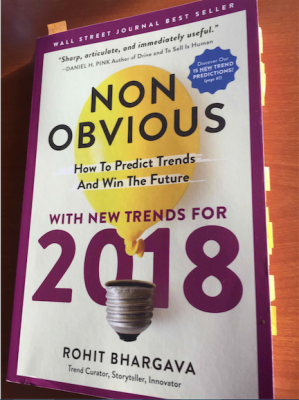Non Obvious 2018 – Rohit Bhargava

The future belongs to those who can learn to use their powers of observation to see the connections between industries, ideas, and behaviors and curate them into a deeper understanding of the world around us.
Preparing for the future starts with filtering out the noise and getting better at understanding today . . . as it alway has.
Rohit Bhargava – Trend Curator, Storyteller, Innovater – has been writing about Non Obvious Trends for a decade. They were first published on his blog, then as a visual presentation on Slideshare, followed by an e-book through Amazon, and eventually as a published book starting in 2011.
I have no idea how this was not on my radar before now. I picked up this book at the popup bookstore operated by Book People at the SXSWEdu in Austin, TX, earlier this month. This is precisely why it’s important to have a well curated selection of books to browse. Books are put before us through excellent curation that we would otherwise miss.
Bhargava sets about collecting ideas throughout the year, marking the hardcopy pages with the salient idea that caught his attention, then he sets them aside in a folder. These are articles from magazines, websites and other resources. He makes it a point to pick up magazines that are wildly disparate in their themes and target audiences – like model train enthusiasts.
Curiosity is key here. And having a wide range of interests is also important. We tend to gravitate to the things we enjoy, or impact our business and career, or validate our existing beliefs. Being open to a broad mix of topics helps to elevate trends away from the the specific subject to the behaviors that might be associated across that broad spectrum.
I like the way this book is put together. Having never read any of his previous Non Obvious books, it was all quite fresh to me in how he explained his process. He talked about his team and how they went about sorting, grouping and naming emerging trends. And his final trends all have well crafted names – another factor that he sees as very important to helping people understand the trend and what it means. At the back of the book, there is a section where he goes back and lists all of his Non Obvious Trends going back to 2011 and rates how well he predicted their impact. That is very interesting.
Some of Non Obvious Trends have been brought forward from earlier years as the concept have evolved, taken shape and grown in their impact. Some of the more interesting ones out of the 15 he identifies for this year are:
Ungendered
Brand Stand
Manipulated Outrage
Data Pollution
Approachable Luxury
Each of the 15 trends have their own section where he talks about how he came to identify the trend and wonderful examples of where they can be seen – using varied examples across multiple industries. I was fascinated by Approachable Luxury and some of the examples he used there. I had no idea they are producing quality diamonds in labs now.
I highly recommend this book. It’s a very interesting and engaging read. I am of a most curious mindset and I enjoy reading the works of writers who are as well.